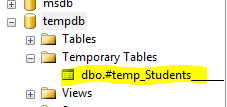SQL Server Temporary Table Vs Table Variable.
This article describes the uses of SQL server Temporary Table and Temp Variable. It also describes the difference between the Temp table and Temp Variable.
Temporary Table
As the name suggests, Temporary Tables are temporary in nature. They are created at run-time, but we can perform all the operations on these tables as can be done on normal/permanent tables. The Temporary tables are created in tempdb database.
Types of Temporary Tables
- Local Temporary Table
- Global Temporary Table
Local Temporary Table
These tables are created by using ‘#’ as prefix for table name. These tables are available only for the user who created it or we can say current user. Also, once the query window is closed the existence of the table gets vanished; i.e. table gets automatically deleted.
Syntax:
CREATE TABLE #<tablename#>
( Column1 datatype, column2 datatype……)
Example
CREATE TABLE #temp_Students
(
StudentName varchar(100),
Stream Varchar(20),
TotalMarks int
)
Temp table #temp_Students get created in tempdb database.

Now insert some records into temp table.
INSERT INTO #temp_Students
VALUES ('Rakhi Sharma','Science',450)
INSERT INTO #temp_Students
VALUES ('Veer Khanna','Accounts',430)
SELECT * FROM #temp_Students

Global Temporary Tables
These tables are created by using ‘##’ as a prefix for the table name. These tables are available in all databases. Whenever the connection is closed global temp table gets deleted.
Syntax:
CREATE TABLE ##<tablename>
( Column1 datatype, column2 datatype……)
Example:
CREATE TABLE ##temp_Employee
(
EmpID int,
EmpFullName varchar(100),
Designation Varchar(50)
)

Inserting records into Global Temporary Table
INSERT INTO ##temp_Employee
VALUES (1001,'Spence Huge','IT Manager')
INSERT INTO ##temp_Employee
VALUES (1002,'Mellisa Karl','Accountant')
SELECT * FROM ##temp_Employee
Now we have got the idea of what Temporary tables are, we should know when to use a global /local temporary table and what the advantages are.
- Complex Queries and Joins – in these kinds of queries Local temporary tables can be used. For more details see Types of SQL Joins with Example.
- Stored Procedures – Whenever we are dealing with Stored Procedures and it require row manipulation Global Temporary tables are best to be used and we can call Procedure from a Procedure, in that case, the existence of a temporary table. For more info see SQL Server Stored Procedure.
Table Variables
Table Variables can be seen as a alternative of using Temporary Tables. These table variables are none less than any other tables as all table related actions can be performed on them. The Syntax of creating a Table Variable is close to creating a normal table but since it is a variable, so we declare a Table Variable. These are declared by using ‘@’ as a prefix for table name.
Syntax:
DECLARE @<tablename> Table
(Column1 datatype,Column2 datatype……, ….)
Example:
DECLARE @ProductInfo TABLE
(
ProductID int,
ProductName Varchar(100),
Cost int
)
INSERT INTO @ProductInfo
VALUES (101,'PLC',15000)
INSERT INTO @ProductInfo
VALUES (201,'Automatic Drives',35000)
While inserting records into Table Variable keep in mind that declaring tables and inserting records and selecting records should be done in a single instance. Otherwise, it would show error - must declare the table variable.

Difference between Temp table and table variable
|
Temp Table (#) |
User defined function (@) |
|---|---|
|
The temp table can be part of Transaction. |
The table variable does not have any effect on the Transaction. |
|
Recompilation of query does not affect on Temp table. |
Recompilation of query has affect on table variables. |
|
Temp table can have a clustered or non clustered index. |
Table variable can have only clustered index. |
|
It allows you SELECT INTO statements to insert data from the existing table. |
It does not allow you SELECT INTO statements to insert data from the existing table. |
|
Temp table can be accessed in nested stored procedure. For example you are working on stored procedure A, from stored proc A you are calling stored proc B. The temp table created in stored proc A can be accessed in stored proc B. |
Table variable cannot be accessed in the nested stored procedure. |
|
Temp table allows TRUNCATE or ALTER table statements. |
Table variable does not allow TRUNCATE or ALTER table statements. |
|
Temp table cannot be used in Used defined functions. |
Table variable can be used in User defined functions. |
Blog Search
-
Building Scalable Applications: Microservice Architecture Challenges
-
The Paradigm Shift to Low-Code and No-Code Development in Software Engineering
-
How To Use AutoMapper in ASP.NET Core Web API
-
Generate Log using Serilog And Seq In ASP.NET Core MVC 6
-
How to Setup CORS Policies in ASP.NET Core Web API

